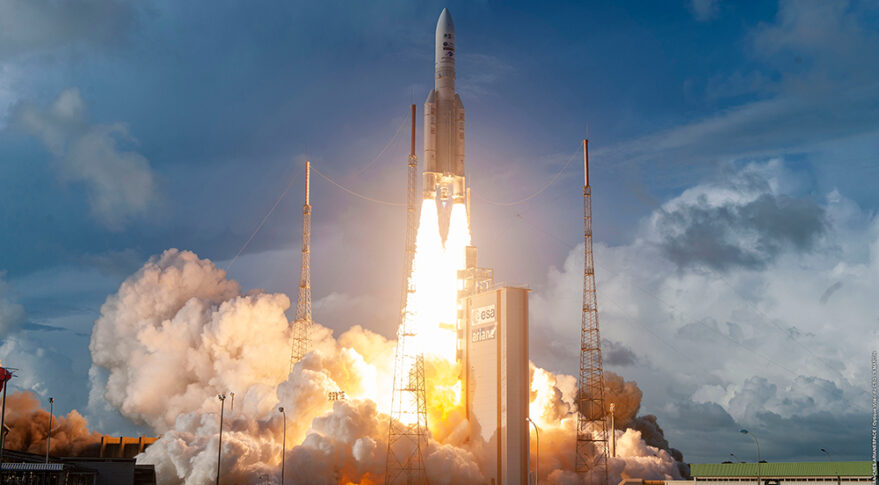
Europe grappling with space access challenges (Image Credit: Space News)
WASHINGTON — The European Space Agency is grappling with multiple issues that could leave Europe temporarily without its own access to space by this summer.
In a Jan. 23 press briefing, ESA Director General Josef Aschbacher said that space transportation issues, including the December failure of a Vega C and the delayed introduction of the Ariane 6, are among his biggest problems entering the new year
“This is something that, let me just be very clear with you, is one of the biggest challenges we have in Europe today,” he said of space transportation. That is a combination of the Vega failure and Ariane 6 delays, along with the loss of the Soyuz rocket last year as fallout from Russia’s invasion of Ukraine and the impending retirement of the Ariane 5, slated to make its final launch in June.
“As of the middle of this year, we do not have guaranteed access to space for Europe by European launchers, and this is a huge problem for all of us,” he said. “We need to really work on this to get back to guarantee access to space for Europe again.”
He said the investigation into the Dec. 20 Vega C launch failure is ongoing. He and other ESA officials at the briefing provided no new technical information about the failure, continuing to state that the failure was linked to the rocket’s second stage. The investigation is expected to wrap up in the second half of February, Aschbacher said.
ESA has not estimated how long it will take to return the Vega C to flight. However, because the second stage of the Vega C is different from the stage used on the original Vega, it may be possible to resume Vega flights first, said Daniel Neuenschwander, ESA director of space transportation. Arianespace previously said there were two Vega launches remaining on its backlog, with about dozen more using the newer Vega C.
Aschbacher said it was a “top priority” to return the Vega C to flight as soon as possible, “but under the right conditions,” noting two previous failures of the Vega before the December Vega C failure. “It requires a deep analysis of some of the quality aspects and we will look into this very seriously.”
As ESA investigates the Vega C failure, it is entering the final stages of testing of the Ariane 6. That includes a Jan. 20 hot-fire test of the rocket’s Vinci upper-stage engine at a facility in Lampoldshausen, Germany. That test lasted for more than 900 seconds and tested both the engine and the upper stage’s auxiliary power unit.
“It allowed us to fully test in nominal conditions the new upper stage,” Neuenschwander said. Future tests, he said, will examine the stage performance in “degraded” conditions.
Tests are also continuing at the launch site to test the integration of the launch vehicle with ground equipment. Electrical tests are underway now with tests of fluid connections scheduled for March. That will be followed by hot-fire tests of the Vulcain 2.1 engine used in the first stage of the Ariane 6.
ESA said last fall it was targeting an inaugural Ariane 6 launch in the fourth quarter of 2023. Aschbacher stuck to that schedule at the briefing but said it was too early to provide a more precise launch date.
As ESA deals with the Vega C and Ariane 6, the agency is also considering ways to support commercial development of small launch vehicles in Europe. Aschbacher said he asked the agency’s space transportation directorate to look into potential competitions to fly ESA payloads on those rockets, making awards even before the first launch of the vehicles.
He said that ESA would continue to wait until a vehicle has made one successful flight before launching satellites on them but could sign contracts for those launches earlier for two reasons. “First of all, it would really accelerate the development on their side,” he said, “but also to give them reassurance that they have an anchor customer who is ready to fly with them.”
Europe also continues to deal with the loss of the Soyuz rocket. It led ESA in October to announce it would launch its Euclid astrophysics mission, originally intended to launch on Soyuz, on a SpaceX Falcon 9 instead. That launch is scheduled for the third quarter of this year, Aschbacher said, likely in July.
There have been reports that Russia and France have been negotiating the return of Soyuz boosters in French Guiana, perhaps in exchange for the 36 OneWeb satellites that have been in storage in Baikonur since Russia canceled their Soyuz launch in March 2022. There are “two and a half” Soyuz boosters in French Guiana, Neuenschwander said.
Aschbacher declined to comment on the reports of a potential swap of Soyuz boosters for OneWeb satellites, calling it an issue for the Russian and French governments.
With Soyuz no longer launching from French Guiana, one issue is what to do with the Soyuz launch site, which was funded by European governments. Neuenschwander said one option is to convert it into a launch site for small launch vehicles. Alternatively, he said it could simply be used as a storage area.








